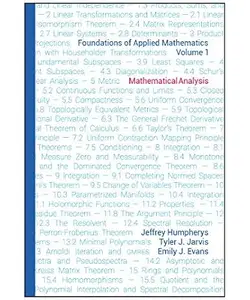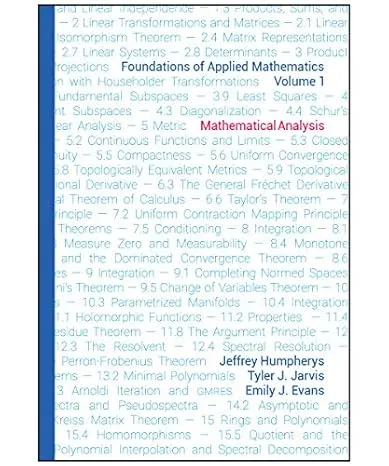Emily J. Evans, "Foundations of Applied Mathematics, Volume 1: Mathematical Analysis"
English | 2017 | ISBN: 1611974895 | PDF | pages: 707 | 198.2 mb
English | 2017 | ISBN: 1611974895 | PDF | pages: 707 | 198.2 mb
This book provides the foundations of both linear and nonlinear analysis necessary for understanding and working in twenty-first century applied and computational mathematics. In addition to the standard topics, this text includes several key concepts of modern applied mathematical analysis that should be, but are not typically, included in advanced undergraduate and beginning graduate mathematics curricula. This material is the introductory foundation upon which algorithm analysis, optimization, probability, statistics, differential equations, machine learning, and control theory are built. When used in concert with the free supplemental lab materials, this text teaches students both the theory and the computational practice of modern mathematical analysis.
Foundations of Applied Mathematics, Volume 1: Mathematical Analysis includes several key topics not usually treated in courses at this level, such as uniform contraction mappings, the continuous linear extension theorem, Daniell Lebesgue integration, resolvents, spectral resolution theory, and pseudospectra. Ideas are developed in a mathematically rigorous way and students are provided with powerful tools and beautiful ideas that yield a number of nice proofs, all of which contribute to a deep understanding of advanced analysis and linear algebra. Carefully thought out exercises and examples are built on each other to reinforce and retain concepts and ideas and to achieve greater depth. Associated lab materials are available that expose students to applications and numerical computation and reinforce the theoretical ideas taught in the text. The text and labs combine to make students technically proficient and to answer the age-old question, 'When am I going to use this?'
Audience: This textbook is appropriate for advanced undergraduate or beginning graduate students in mathematics and, potentially, graduate students in physics, engineering, statistics, or computer science.
Contents: List of Notation; Foreword; Preface; Part I: Linear Analysis I; Chapter 1: Abstract Vector Spaces; Chapter 2: Linear Transformations and Matrices; Chapter 3: Inner Product Spaces; Chapter 4: Spectral Theory; Part II: Nonlinear Analysis I; Chapter 5: Metric Space Topology; Chapter 6: Differentiation; Chapter 7: Contraction Mappings and Applications; Part III: Nonlinear Analysis II; Chapter 8: Integration I; Chapter 9: Integration II; Chapter 10: Calculus on Manifolds; Chapter 11: Complex Analysis; Part IV: Linear Analysis II; Chapter 12: Spectral Calculus; Chapter 13: Iterative Methods; Chapter 14: Spectra and Pseudospectra; Chapter 15: Rings and Polynomials; Part V: Appendix; Appendix A: Foundations of Abstract Mathematics; Appendix B: The Complex Numbers and Other Fields; Appendix C: Topics in Matrix Analysis; Appendix D: The Greek Alphabet; Bibliography; Index.



